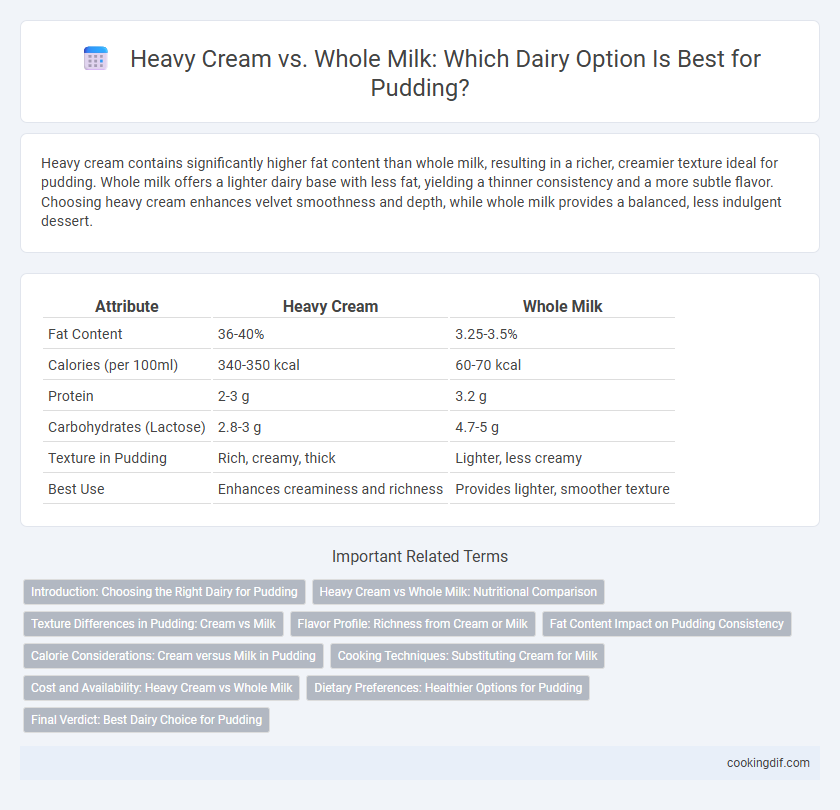Heavy cream contains significantly higher fat content than whole milk, resulting in a richer, creamier texture ideal for pudding. Whole milk offers a lighter dairy base with less fat, yielding a thinner consistency and a more subtle flavor. Choosing heavy cream enhances velvet smoothness and depth, while whole milk provides a balanced, less indulgent dessert.
Table of Comparison
| Attribute | Heavy Cream | Whole Milk |
|---|---|---|
| Fat Content | 36-40% | 3.25-3.5% |
| Calories (per 100ml) | 340-350 kcal | 60-70 kcal |
| Protein | 2-3 g | 3.2 g |
| Carbohydrates (Lactose) | 2.8-3 g | 4.7-5 g |
| Texture in Pudding | Rich, creamy, thick | Lighter, less creamy |
| Best Use | Enhances creaminess and richness | Provides lighter, smoother texture |
Introduction: Choosing the Right Dairy for Pudding
Heavy cream contains about 36-40% milk fat, offering a rich, creamy texture ideal for smooth, velvety puddings, while whole milk, with about 3.25% fat, yields a lighter, less dense consistency. The higher fat content in heavy cream enhances the pudding's mouthfeel and stability, making it preferable for recipes requiring thick, luscious results. Selecting the right dairy depends on the desired richness and texture, with heavy cream providing decadence and whole milk offering a subtle, milkier flavor profile.
Heavy Cream vs Whole Milk: Nutritional Comparison
Heavy cream contains approximately 36-40% fat, offering a rich, creamy texture and higher calorie content than whole milk, which typically has about 3.25% fat. Whole milk provides essential nutrients such as calcium, vitamin D, and protein but has significantly fewer calories and saturated fat compared to heavy cream. Choosing between heavy cream and whole milk impacts the dairy content and nutritional profile of pudding, affecting its creaminess, calorie density, and fat content.
Texture Differences in Pudding: Cream vs Milk
Heavy cream, with its higher fat content of around 36-40%, creates a richer, thicker pudding texture compared to whole milk's 3.25% fat, which results in a lighter, more fluid consistency. The fat in heavy cream enhances creaminess and stability, preventing the pudding from separating or becoming grainy. Using whole milk yields a smoother but less decadent pudding, making heavy cream the preferred choice for a luxuriously dense mouthfeel.
Flavor Profile: Richness from Cream or Milk
Heavy cream offers a significantly richer and creamier flavor profile in pudding due to its high fat content, typically around 36-40%, which enhances mouthfeel and luxurious texture. Whole milk, with approximately 3.5% fat, provides a lighter, more subtle dairy taste that allows other ingredients to shine without overwhelming richness. Choosing heavy cream results in a decadent, velvety pudding, while whole milk yields a smoother, more delicate flavor experience.
Fat Content Impact on Pudding Consistency
Heavy cream contains approximately 36-40% fat, significantly higher than whole milk, which averages around 3.25% fat, directly impacting pudding consistency by creating a richer, creamier texture. The increased fat content in heavy cream enhances the smoothness and thickness of pudding, providing a luxurious mouthfeel and preventing it from becoming watery or thin. In contrast, whole milk yields a lighter pudding with less body, often requiring additional thickeners or stabilizers to achieve a comparable creamy consistency.
Calorie Considerations: Cream versus Milk in Pudding
Heavy cream contains approximately 52 calories per tablespoon with about 5 grams of fat, significantly increasing the calorie content of pudding compared to whole milk, which has around 9 calories per tablespoon and 0.5 grams of fat. Using heavy cream results in richer texture and higher fat content, making pudding more calorie-dense, while whole milk offers a lighter alternative with fewer calories and less fat. Choosing between heavy cream and whole milk depends on desired creaminess and calorie goals in pudding recipes.
Cooking Techniques: Substituting Cream for Milk
Heavy cream, containing approximately 36-40% fat, offers a rich texture and creamy mouthfeel that enhances pudding's smoothness and thickness when used instead of whole milk, which typically has about 3.25% fat. Cooking with heavy cream requires careful temperature control to prevent curdling and to maintain a velvety consistency, while whole milk allows for a lighter pudding but may need thickening agents like cornstarch to achieve the desired density. Substituting cream for milk intensifies flavor and richness, making it ideal for custard-based puddings where a luxurious texture is paramount.
Cost and Availability: Heavy Cream vs Whole Milk
Heavy cream contains higher dairy fat content than whole milk, making it more expensive and less readily available in some grocery stores. Whole milk offers a cost-effective and widely accessible option for pudding recipes, delivering sufficient creaminess with lower fat. Choosing between the two depends on budget constraints and local availability, with whole milk being the preferred dairy for affordability and convenience.
Dietary Preferences: Healthier Options for Pudding
Heavy cream contains significantly higher fat content than whole milk, with about 36-40% fat versus whole milk's 3.25%, making it richer and creamier for pudding textures. Whole milk offers a lighter, lower-calorie option suitable for those seeking reduced saturated fat intake while maintaining adequate protein levels. Choosing whole milk supports dietary preferences focused on heart health and calorie control without sacrificing the smooth consistency essential in pudding recipes.
Final Verdict: Best Dairy Choice for Pudding
Heavy cream enhances pudding with a rich, velvety texture and higher fat content, making it the best choice for a creamy, indulgent dessert. Whole milk offers a lighter alternative with fewer calories but yields a thinner consistency and less depth in flavor. For optimal pudding quality, heavy cream is preferred due to its superior dairy content and ability to create a smooth, luxurious mouthfeel.
Heavy cream vs Whole milk for dairy content Infographic

 cookingdif.com
cookingdif.com